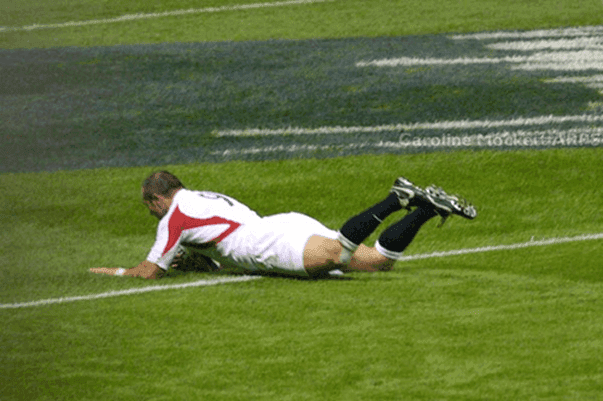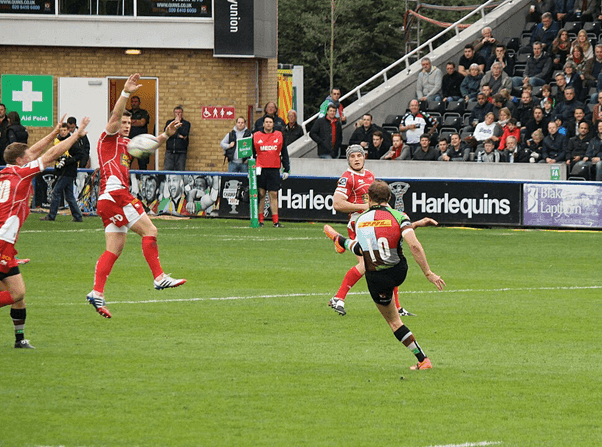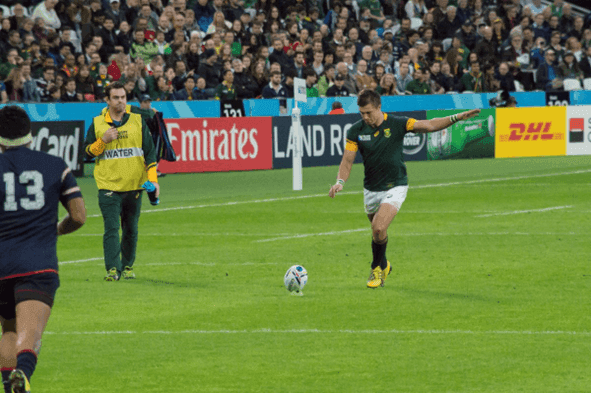Rugby
Rugby Points-Scoring System Explained
Rugby union has changed a lot in the two centuries since William Webb Ellis inspired a new sport in 1823. This is a breakdown of rugby’s point-scoring system.

Image Credits: Lionel Hahn/Getty Images
A form of rugby union has been played ever since William Webb Ellis picked up the ball, ran across the football field and dived into the goals at Rugby School in 1823. Some historians dispute the event ever took place. History became legend, legend became myth, and one of the most popular sports in the world was born.
There are several ways to score points in rugby union. A “try” is scored when an attacker touches down the ball behind the opposition’s “goal line.” In the early days of rugby, this score was known as a “touch down.” Currently, five points are awarded for a try. The kicker takes a conversion attempt in line with where try was scored. The kicker can place the ball on a tee or drop kick the conversion.

Image Credits: Unofficial England Rugby // CC BY 2.0
If the conversion is successful, two points are added to the score. A shot at goal from a penalty and a drop kick (field goal) is worth three. SportsBoom researched the rugby archives to find the points-scoring system since rugby union became codified after breaking away from the Football Association in 1863.
A History of Points Scoring in Rugby Union
Rugby union is a form of rugby football commonly known as rugby. In August 1845, the first laws were written by students at Rugby School. Rugby’s points-scoring system has changed multiple times since the first laws of the game were introduced to the newly codified sport in the mid-nineteenth century.
The 1845 lawbook stated a “try at goal” is only awarded once the place-kicked ball went through the uprights and over the crossbar. A goal was worth one point. If the kick was missed, the score did not count. In modern-day rugby, a converted try (seven points) is called a “goal” (five points for a try, two for a conversion).
Since the scoring system began, a try has been worth no points to five points. However, variations on awarding points have changed often. In 1871, Rugby Football Union (RFU) matches were decided “by the majority of goals” not tries.

Image Credits: G-Man // Public Domain
By 1875, the scoring law was modified. A match was decided by the “majority of goals, but if the number of goals is equal, or no goals be kicked, by a majority of tries.” A try would be an unconverted goal. In 1877, a goal was only “scored if kicked from a try” and worth one point. Many variations and changes to the laws were accepted and rejected.
The International Rugby Football Board (IRFB) took over governance of the game in 1886, changing the scoring system from goals to points. In 1888, the “fair catch” law was introduced. This rule introduced a second system of scoring a goal (of lesser value), and matches were decided by whoever scored the most points. The lawbook stated, “A goal shall equal three points,” except for a “goal kicked from a kick awarded by way of penalty, which shall equal two points, and a try, one point.”
The History of Rugby Union Scoring System
| Date | Try | Conversion | Penalty | Drop Goal | Goal from Mark |
| 1871-1875* | No Score | 1 Goal | 1 Goal | 1 Goal | - |
| 1876-1885* | 1 Try | 1 Goal | 1 Goal | 1 Goal | - |
| 1886-1891^ | 1 Point | 2 Points | 3 Points | 3 Points | - |
| 1891-1894 | 2 Points | 3 Points | 3 Points | 4 Points | 4 Points |
| 1894-1904 | 3 Points | 2 Points | 3 Points | 4 Points | 4 Points |
| 1905-1947 | 3 Points | 2 Points | 3 Points | 4 Points | 3 Points |
| 1948-1970 | 3 Points | 2 Points | 3 Points | 3 Points | 3 Points |
| 1971-1977 | 4 Points | 2 Points | 3 Points | 3 Points | 3 Points |
| 1977-1991 | 4 Points | 2 Points | 3 Points | 3 Points | - |
| 1992-Present | 5 Points | 2 Points | 3 Points | 3 Points | - |
*RFU systems before the inception of the International Rugby Football Board (IRFB)
^Scoring systems after the administration of rugby was taken over by the IRFB – now known as World Rugby
“If the number of points is equal or no goals be kicked or try obtained, the match shall be drawn. When a goal is kicked from a try, the goal only is scored.” In 1891, the IRFU amended the points-scoring system. A try would be worth two points, a penalty goal three, and a goal from a try (the try did not count) five points. Other goals equalled four points. If the number of points were equal, or no team had kicked a goal or scored a try, the game would end as a draw.
Three years later, in 1894, the Rugby Football Union and Wales Rugby Union increased the value of a try from two to three points. The value of a conversion was reduced by one point to two. A goal (converted try) remained five points. Over time, the scoring value system continued to change.

Image Credits: Charlie // CC BY 2.0
By September 1971, IRFU introduced a two-year trial for the new value for a try, which increased to four points from three. A goal from a mark was rare. The “free-kick” clause was introduced in 1977, ending the three-point goal from a mark. In April 1992, the IRFU increased the value of a try from four to five points. Since 1893, a penalty has been three points and a conversion two.
The most recent change to rugby union’s scoring system came in 2017. Before 2017, a penalty try was worth five points. The kicker had to convert from in front of the posts for the penalty try for seven points. On the rare occasion that the conversion was unsuccessful, the attacking team scored five points. The updated penalty try scoring system is worth seven. The conversion is no longer attempted.

Image Credits: David Roberts // CC BY 2.0

Kaylan Geekie is a sports fanatic. He attended Durban High School before moving to Scotland, where he lived for 15 years. During his time in the United Kingdom, Kaylan graduated with a first-class BA Honours Degree in Sports Journalism at the University of the West of Scotland. Kaylan worked for nine years as the Match-Day Editor of SuperXV.com, reporting on Super Rugby, The Rugby Championship, the 2015 Men's Rugby World Cup and the 2017 British & Irish Lions series for the website.